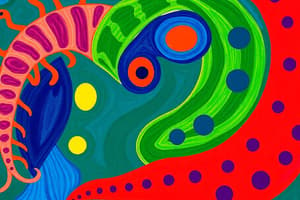Podcast
Questions and Answers
What is the body structure of Nematoda?
What is the body structure of Nematoda?
- Cylindrical and unsegmented (correct)
- Segmentation
- Irregular shape
- Flat and segmented
All nematodes are parasitic and cannot live freely.
All nematodes are parasitic and cannot live freely.
False (B)
Name one example of a nematode that is known to be a human parasite.
Name one example of a nematode that is known to be a human parasite.
Ascaris lumbricoides
Nematodes are classified as ___ due to their body cavity structure.
Nematodes are classified as ___ due to their body cavity structure.
Match the following classes of Nematoda with their features:
Match the following classes of Nematoda with their features:
What type of symmetry do nematodes exhibit?
What type of symmetry do nematodes exhibit?
What is the function of a stylet in nematodes?
What is the function of a stylet in nematodes?
Which class of flatworms is characterized by being free-living?
Which class of flatworms is characterized by being free-living?
Flatworms exhibit radial symmetry.
Flatworms exhibit radial symmetry.
What type of digestive system do flatworms possess?
What type of digestive system do flatworms possess?
The first multicellular organism with a fully sequenced genome is _.
The first multicellular organism with a fully sequenced genome is _.
Match the following diseases with their causative agents:
Match the following diseases with their causative agents:
What is the primary function of flame cells in the excretory system of flatworms?
What is the primary function of flame cells in the excretory system of flatworms?
What is a common characteristic of the reproductive system in flatworms?
What is a common characteristic of the reproductive system in flatworms?
Parasitic nematodes have a complex life cycle involving intermediate and definitive hosts.
Parasitic nematodes have a complex life cycle involving intermediate and definitive hosts.
Parasitic flatworms belong to the class _.
Parasitic flatworms belong to the class _.
Which class of mollusks is characterized by having a cap-shaped shell and typically inhabits deep-water environments?
Which class of mollusks is characterized by having a cap-shaped shell and typically inhabits deep-water environments?
All arthropods have a closed circulatory system.
All arthropods have a closed circulatory system.
What feature distinguishes Class Bivalvia from other classes of mollusks?
What feature distinguishes Class Bivalvia from other classes of mollusks?
The __________ is the basic larval stage found in many mollusks.
The __________ is the basic larval stage found in many mollusks.
Match the following classes of mollusks to their characteristics:
Match the following classes of mollusks to their characteristics:
What is the primary method by which tapeworms absorb nutrients from their host?
What is the primary method by which tapeworms absorb nutrients from their host?
The tapeworm lifecycle only involves definitive hosts, which are typically humans.
The tapeworm lifecycle only involves definitive hosts, which are typically humans.
What are two examples of species that belong to the Taenia genus?
What are two examples of species that belong to the Taenia genus?
Schistosomiasis is caused by the _____ species.
Schistosomiasis is caused by the _____ species.
Match the parasitic diseases to their corresponding symptoms:
Match the parasitic diseases to their corresponding symptoms:
What practical measure can help prevent schistosomiasis?
What practical measure can help prevent schistosomiasis?
Tapeworms have a well-developed digestive system to process food.
Tapeworms have a well-developed digestive system to process food.
What is the treatment for schistosomiasis?
What is the treatment for schistosomiasis?
Annelids have a _____ circulatory system that is closed.
Annelids have a _____ circulatory system that is closed.
Which of the following structures are found in the Class Cestoda?
Which of the following structures are found in the Class Cestoda?
Which of the following is a characteristic of the class Polychaeta?
Which of the following is a characteristic of the class Polychaeta?
Earthworms have a clitellum which is used for mucus secretion during reproduction.
Earthworms have a clitellum which is used for mucus secretion during reproduction.
What is the primary role of nephridia in the excretory system of annelids?
What is the primary role of nephridia in the excretory system of annelids?
The __________ is a dorsal epithelium that secretes the shell in mollusks.
The __________ is a dorsal epithelium that secretes the shell in mollusks.
Match the class of annelids to its characteristic:
Match the class of annelids to its characteristic:
Which statement describes the body structure of mollusks?
Which statement describes the body structure of mollusks?
Sludge worms are an indicator species that thrive in clean waters.
Sludge worms are an indicator species that thrive in clean waters.
What economic use do earthworms have?
What economic use do earthworms have?
The largest group of annelids with over 10,000 species is called __________.
The largest group of annelids with over 10,000 species is called __________.
Match the following examples with their respective groups:
Match the following examples with their respective groups:
Flashcards
Nematode
Nematode
A cylindrical, unsegmented worm belonging to the phylum Nematoda, commonly known as roundworms, threadworms, or nematodes.
Pseudocoelom
Pseudocoelom
A body cavity that is not completely lined by mesoderm, found in nematodes.
Cuticle
Cuticle
A protective, non-cellular covering that protects the nematode's body.
Stylet
Stylet
Signup and view all the flashcards
Complete Digestive System
Complete Digestive System
Signup and view all the flashcards
Gonochoristic
Gonochoristic
Signup and view all the flashcards
Model Organism
Model Organism
Signup and view all the flashcards
Flatworms
Flatworms
Signup and view all the flashcards
Planaria
Planaria
Signup and view all the flashcards
Schistosomiasis
Schistosomiasis
Signup and view all the flashcards
Monoecious
Monoecious
Signup and view all the flashcards
Flame Cells
Flame Cells
Signup and view all the flashcards
Eumetazoan
Eumetazoan
Signup and view all the flashcards
Cephalization
Cephalization
Signup and view all the flashcards
Parasitic Flatworms
Parasitic Flatworms
Signup and view all the flashcards
What is a 'radula'?
What is a 'radula'?
Signup and view all the flashcards
What are 'ctenidia'?
What are 'ctenidia'?
Signup and view all the flashcards
What is 'torsion'?
What is 'torsion'?
Signup and view all the flashcards
What are 'chromatophores'?
What are 'chromatophores'?
Signup and view all the flashcards
What are 'metanephridia'?
What are 'metanephridia'?
Signup and view all the flashcards
Cestoda
Cestoda
Signup and view all the flashcards
Proglottids
Proglottids
Signup and view all the flashcards
Parasitic Adaptation
Parasitic Adaptation
Signup and view all the flashcards
Intermediate Host
Intermediate Host
Signup and view all the flashcards
Definitive Host
Definitive Host
Signup and view all the flashcards
Taeniasis
Taeniasis
Signup and view all the flashcards
Metameres or Somites
Metameres or Somites
Signup and view all the flashcards
Parapodia
Parapodia
Signup and view all the flashcards
Annelid Body Plan
Annelid Body Plan
Signup and view all the flashcards
Annelid Reproduction
Annelid Reproduction
Signup and view all the flashcards
Annelid Nervous System
Annelid Nervous System
Signup and view all the flashcards
What are Polychaetes?
What are Polychaetes?
Signup and view all the flashcards
Oligochaetes: Earthworms
Oligochaetes: Earthworms
Signup and view all the flashcards
Hirudinea: Leeches
Hirudinea: Leeches
Signup and view all the flashcards
Annelids: Ecological Roles
Annelids: Ecological Roles
Signup and view all the flashcards
Annelids: Economic Importance
Annelids: Economic Importance
Signup and view all the flashcards
Annelids as Indicator Species
Annelids as Indicator Species
Signup and view all the flashcards
Definition of Mollusca
Definition of Mollusca
Signup and view all the flashcards
Study Notes
Phylum Nematoda
- Common Names: Roundworms, threadworms, nematodes
- Etymology: Derived from Greek words nema (thread) and odes (resembling)
- Habitat: Ubiquitous – terrestrial, aquatic; free-living or parasitic
- Body Size: Microscopic (82µm) to macroscopic (>8m)
- Body Structure: Cylindrical, unsegmented; pseudocoelomate (with a body cavity); covered by a protective cuticle
Characteristics
- Tissue Type: Eumetazoan (true tissues)
- Germ Layers: Triploblastic (ectoderm, mesoderm, endoderm)
- Symmetry: Bilateral symmetry
- Digestive System: Complete (mouth and anus)
- Excretory System: Poorly developed; includes excretory pore
- Circulatory System: Absent; relies on diffusion
- Nervous System: Nerve cords, ganglia, paired sense organs (amphids anterior; phasmids posterior)
- Reproduction: Sexual (gonochoristic – separate sexes), internal fertilization; males often have hooked posterior ends
Adaptations
- Cuticle: Noncellular protective covering
- Stylet: Piercing mouthpart for feeding and secretion
- Valve: Regulates food movement, prevents regurgitation
- Movement: Whip-like motion due to longitudinal muscles
Classes and Examples
Class Chromadorea
- Features: Amphids (pore-like/slit-like), phasmids present or absent, esophagus with 3–5 glands
- Examples:
- Ascaris lumbricoides (intestinal roundworm; human parasite)
- Wuchereria bancrofti (causes filariasis/elephantiasis)
- Caenorhabditis elegans (model organism for genetics, aging, and neuroscience)
Class Enoplea
- Features: Amphids (pocket-like for smell), phasmids present, bottle-shaped esophagus
- Examples:
- Trichinella spiralis (pork worm; causes trichinosis)
Studying That Suits You
Use AI to generate personalized quizzes and flashcards to suit your learning preferences.




